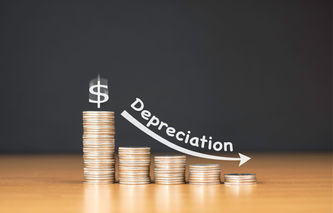Definition
The term declining balance depreciation refers to one of several methods of allocating the cost of an asset over its expected lifetime. The declining balance depreciation method is an accelerated approach to depreciation, and is based on the assumption an asset's value declines at a greater rate in the early years of its serviceable life.
Calculation
Declining Balance Depreciation (%) = 2 / Serviceable Life of Asset
Explanation
Also known as the double-declining balance and reducing balance method, the declining balance approach to depreciation is an accelerated method, since it results in higher depreciation values in the early years of the asset's life relative to the straight line method. This approach is based on the assumption an asset provides greater value when it is newer.
The declining balance method does not take into consideration the salvage value of the asset when calculating the annual depreciation expense. However, the book value of the asset can never be lower than its salvage value. Adjustments need to be made to the final year of depreciation to prevent the book value from falling below the asset's salvage value.
Depreciation is an accounting method of cost allocation. It is used to allocate the cost of an asset over its useful life. Depreciation allows the cost of a balance sheet item (an asset) to flow smoothly to the income statement (as an expense) over its serviceable life.
Example
Company A purchases a backup generator for $200,000. The service life of the generator is expected to be 10 years. The generator is estimated to have a scrap value of $50,000 at the end of its serviceable life. The declining balance depreciation rate would be:
= 2 / 10 or 20% per year
In the first year of operation, the depreciation expense for this generator would be:
= 20% x $200,000 = 0.2 x $200,000, or $40,000
A complete declining balance depreciation schedule for the asset is shown below:
Depreciation Expense | Accumulated Depreciation | Book Value | |
Year 0 | $200,000 | ||
Year 1 | $40,000 | $40,000 | $160,000 |
Year 2 | $32,000 | $72,000 | $128,000 |
Year 3 | $25,600 | $97,600 | $102,400 |
Year 4 | $20,480 | $118,080 | $81,920 |
Year 5 | $16,384 | $134,464 | $65,536 |
Year 6 | $13,107 | $147,571 | $52,429 |
Year 7 | $2,429 | $150,000 | $50,000 |
Note that in Year 7, the depreciation expense is capped at $2,429 to prevent the book value of the generator from falling below the scrap value of the asset ($50,000).





.png)